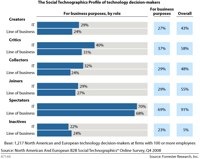BusinessWeek says smart companies are using Twitter and Facebook—are you? We can help.
I am honored to be featured again in BusinessWeek as one of 50 CEOs Who Twitter, as a part of a larger story on social media. As I was just discussing the growth of interest in social media campaigns this morning with the PerkettPR crew, this is a timely article. We continue to receive incoming queries from companies in many industries that want to learn how to elevate brand awareness with social media campaigns. The opportunities are both allowing us to expand the industries in which we work, the brands that we work with and the work that we do. We’re going far beyond traditional public relations and as I mentioned last week, we believe that this is the natural evolution for the PR industry.
That being said, so many of the brands that we speak with have no idea where to begin. They still aren’t convinced or sure of the value of “social media” and they want to approach it with kid gloves. They are worried about time, resources, control and execution. And we understand why – we’ve been there! We’ve also helped a lot of companies come from that place and embrace the opportunities of becoming a “social company.” And we love doing it because as you can see, we’re heavily involved in social media ourselves. We believe in it, we appreciate and understand it, and we continually see value and results from it.
Social Media U
To share our enthusiasm, we’re pleased to announce a new program designed to help companies in any industry understand and embrace social media for business. Our “Social Media U” offering was born out of the interest and feedback we’ve received for speaking on social media for business and social media for communicators. Sharing our best practices, experience and insights, Social Media U will help any executive make sense of the noise and clarify just what types of social strategies can work for your business. While articles like BusinessWeek’s are helpful, many executives need more than a DIY guide. And as the CEO of Forrester Research, George Colony, recently wrote, “You can’t understand Twitter, Facebook, or blogging by reading an article in a magazine or a report from your CMO. Sure, they can tell you what they are, but you won’t be able to truly understand how they could change your business unless you actually use them.”
That’s where we can help.
Quick facts about PerkettPR’s Social Media U:
- Social Media U is an affordable, intensive half or full day workshop
- While we prefer to meet face-to-face, we can (and have successfully done so) execute the workshop via web conference
- We offer three levels of engagement to choose from – based on your knowledge level and needs
- We’ll teach you what social media is and how to engage and embrace it for your business
- Appropriate for any business that wants to understand social media, the potential value to their business, how to get started and how to maintain effective social strategies
What you’ll learn:
- From the C-Suite to the front desk – why social media strategies involve everyone at your company
- Why Facebook isn’t just for keeping up with friends and family, LinkedIn is so much more than a rolodex and how Twitter benefits your brand
- How to effectively monitor and respond in social media communities such as Twitter, LinkedIn, Facebook, Yahoo! Answers and more
- Which blogs matter to you and how to participate in the blogosphere even if you don’t have your own
- How to easily create content for your blog, website and customer communications
- Effective and realistic strategies for engaging customers, prospects and partners: from blog posts to video, Twitter to microsites
- How to trust the community and build positive relationships for your company
Why we’re qualified
- We’ve been integrating social media into PR campaigns for years now and have been recognized as one of a handful of PR firms leading the charge (many call it PR 2.0)
- As senior PR professionals, we understand communications and the larger picture of how it must all come back to your company’s business goals – read here about why we think this matters
- We’re heavily involved in social media for our own business
- We’ve trained clients in many industries and of many sizes – from SMBs to public companies; fashion to technology – on effective social media strategies
- We’ve presented strategies at numerous conferences for thousands of executives
For more information please email SMU[at]perkettpr.com – or call me personally: 781.834.5852.







